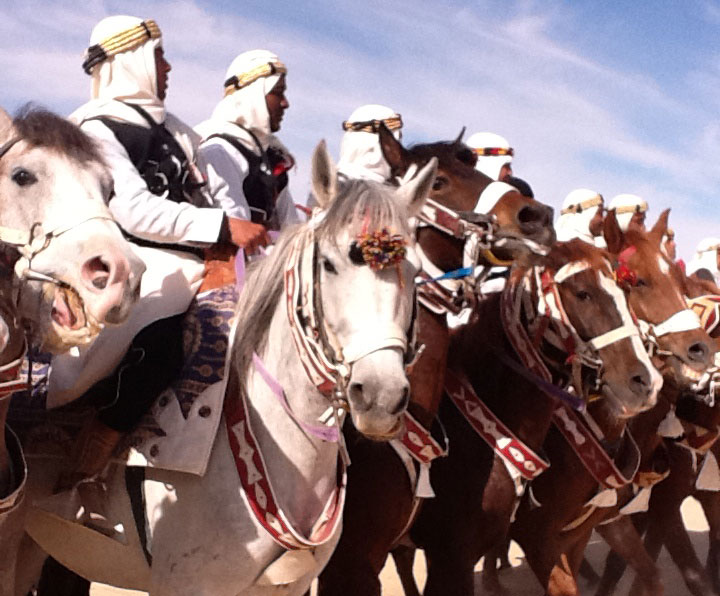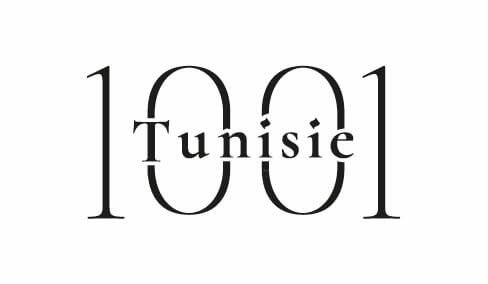
Thoroughbred, Beard, Arab-Barb and Pony Mogods; horse breeding began in Sidi Thabet (suburb of Tunis) in the late nineteenth century. After the first experiences from crosses between local and foreign breeds, breeding has found its way into the import of Arab thoroughbreds and the creation of a horses improvement center in the northwest of the country. Today, the stud Sidi Thabet El Battan, Raccada, Maknessy Ben Guerdane, Kairouan, Sidi Bouzid and Medenine perpetuate the Tunisian horse. Racecourses Ksar Said and Monastir allow riders to compete and the public to participate in the great Tunisian equestrian adventure. As part of large popular festivals, such as the Sahara Douz Festival held each year in December, or more impromptu parties, the Tunisian rider showed he has lost none of its secular mastery by engaging in spectacular fantasias on horseback. Beard and Mogod, plains kings and princes mountains Among the thoroughbred, Beard, Arab-Barb and Pony Mogods equine heritage of Tunisia, there are lowland and mountain horses. The “Beard” is undeniably one of the kings of the plains. Its name comes from the word “Berber” meaning “native of North Africa.” Gentle, calm, strong and built for endurance, “Barbe,” heir to 3000 years of history, is a little the ancestor of many horse breeds in the world. Companion of Henri IV, Louis XIV, Napoleon … it is now the perfect horse for equestrian sports and a key asset for the Tunisian equestrian tourism. The prince of the mountains, it is the “Mogod” or Tunisian pony. To shelter successive invasions, he took refuge in the mountainous area between Bizerte, Mateur, Béja Ain Drahem and Tabarka. Become a real mountain, the “Mogod” proved perfect for the saddle; making it an ideal adjunct for coupling small carts, polo games and other luxury services. Agility, calm and energetic character make it the ideal companion for children and young riders in the making. A good reason to perpetuate this race, linked to the great adventure of riding in Tunisia.
Beard and Mogod, plains’ kings and mountains’ princes
Among the thoroughbred, Beard, Arab-Barb and Pony Mogods equine heritage of Tunisia, there are lowland and mountain horses. The “Beard” is undeniably one of the kings of the plains. Its name comes from the word “Berber” meaning “native of North Africa.” Gentle, calm, strong and built for endurance, “Barbe,” heir to 3000 years of history, is a little the ancestor of many horse breeds in the world. Companion of Henri IV, Louis XIV, Napoleon … it is now the perfect horse for equestrian sports and a key asset for the Tunisian equestrian tourism. The prince of the mountains, it is the “Mogod” or Tunisian pony. To shelter successive invasions, he took refuge in the mountainous area between Bizerte, Mateur, Béja Ain Drahem and Tabarka. Become a real mountain, the “Mogod” proved perfect for the saddle; making it an ideal adjunct for coupling small carts, polo games and other luxury services. Agility, calm and energetic character make it the ideal companion for children and young riders in the making. A good reason to perpetuate this race, linked to the great adventure of riding in Tunisia.
Equestrian sport opens on Tourism
The horse Tunisia is a gateway to other tourism. As we said Ikbel Bedoui , Chairman of the Organizing Committee of ” 114 trophies ,” such an organization attract ” foreign competitors who come to Tunisia with their horses and guides. This is a niche to be exploited for a clientele with high purchasing power who pays the transportation of horses (3 000 euros per horse ) and the airfare and stay for several people . ” Horse shows are affirmed therefore as “a product for a premium customer for Tunisia. They are included in the international calendar and judiciously combine the appeal of sport and tourism . ”
A Discovery Riding
Equestrian tourism , they are also raids to discover the country otherwise. This formula is for horse enthusiasts and discovery, and the curious can take a few hours in the saddle. The equestrian center of the Hotel “The Sultan” in Hammamet, the joys of horse and galusic3ops on the beach , combined with discoveries like the traditional market of ” Sidi Djedidi ” bathing in natural hot springs from ” Lella Khadija ” , a detour to the Zaghouan agricultural region or by ” sebkha ” Enfidha … in “nomadic Ranch ” in Ksar Ghilane , is the discovery of the desert, the nomadic culture and its equestrian traditions which will make your stay unforgettable.
, combined with discoveries like the traditional market of ” Sidi Djedidi ” bathing in natural hot springs from ” Lella Khadija ” , a detour to the Zaghouan agricultural region or by ” sebkha ” Enfidha … in “nomadic Ranch ” in Ksar Ghilane , is the discovery of the desert, the nomadic culture and its equestrian traditions which will make your stay unforgettable.
Traditional Horse riding or “Horse Play”
Symbol of the warrior virtuosity, “lab el Baroud” (game of the powder), or “laab El Kheil” (game of the horses) is an authentic equestrian tradition that simulates attacks and the Arab and Berber tactic of military tradition. The riding consists of “MCHEF” during which one or two riders play the “last stand” and perform stunts using as the aerobatic techniques as much showing the courage of the riders as that the of the speed of the horse. The “aked” is a group of tactics that engage between 5 and 20 riders in the form of a warhead. This is a theatrical rehearsal of the two movements of the cavalry in war: fast charge “el kerr” and the sudden retreat “el ferr”. The dressage horse responds to specific rules and rider becomes one with his mount and must know the exact sequence figures prepared in groups
The art of celebration
Synonymous with celebrations on the occasion of some rites ( as the ” moussem ” or “zerda ” – annual festivals dedicated to a saint) or certain religious festivals suchas ” Eid El Fitr ,” the parade is a jovial term the Tunisian traditional horsemanship . She also accompanies the celebration of marriages escorting the
horsemanship . She also accompanies the celebration of marriages escorting the
bride to her husband. This is called the ” Mdawari ” a festive riding that emphasizes the art of living around the horse in Tunisia. Introduced by Hilalians , horses are then dressed in regalia .They dance to the rhythm of drums and women leave their overflowing joy at the sound of a thousand and one “dinghies ” to each of their acrobatics


 َAbonnez-vous
َAbonnez-vous

